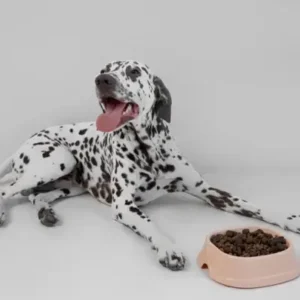Health Risks of Cherries for Dogs
To ensure your dog’s safety, it’s important to be aware of the potential health risks associated with cherries.
Here’s a closer look at the key dangers.
- Choking Hazard from Cherry Pits: One of the biggest concerns with cherries is the pit. Cherry pits can cause choking, especially in small dogs. If the pit gets lodged in your dog’s throat, it could block their airway and lead to suffocation.
- Cyanide Toxicity: The cherry pit contains cyanide, which is highly toxic to dogs. Ingesting cherry pits can lead to symptoms of cyanide poisoning such as drooling, difficulty breathing, and even death in severe cases. Therefore, it’s crucial to ensure that all cherry pits are removed before feeding them to your dog.
- Digestive Issues: Even without the pits, cherries can cause digestive upset in dogs if eaten in large quantities. Too many cherries can lead to stomachaches, diarrhea, and vomiting. Moderation is key.
How Many Cherries Can Dogs Eat?
Treats, including healthy fruits like cherries, should only make up about 10% of your dog’s daily diet. The remaining 90% should come from a balanced, nutritious dog food. When giving cherries to your dog, it’s important to feed them in moderation and adjust based on your dog’s size.
Below is a general guideline for how many cherries you can safely give your dog, depending on their size and dog breed:
| Dog Size | Weight Range | Safe Cherry Amount | Examples |
| Extra-small dog | 2–20 pounds | 1 cherry | French Bulldog, Dachshund, Yorkshire Terrier, Shih Tzu, Chihuahua |
| Small dog | 21–30 pounds | Up to 2 cherries | Cavalier King Charles Spaniel, Boston Terrier, Cocker Spaniel, Bichon Frise, Cockapoo |
| Medium dog | 31–50 pounds | Up to 4 cherries | Siberian Husky, Bulldog, Shiba Inu, Border Collie, Catahoula Leopard Dog |
| Large dog | 51–90 pounds | Up to 5 cherries | Doberman, Akita, Boxer, Samoyed, Dogo Argentino, Vizsla |
| Extra-large dog | 91+ pounds | Handful of cherries | Bernese Mountain Dog, Saint Bernard, Boerboel, Chinook |
Signs Your Dog May Have Eaten Too Many Cherries
If your dog accidentally ingested too many cherries, keep an eye out for the following symptoms of an upset stomach and intestinal obstruction:
- Diarrhea
- Vomiting
- Lack of appetite
- Lethargy
- Painful or distended stomach
If you notice any of these signs, contact your veterinarian promptly.
Can Dogs Eat Cherry Flesh?
Yes, the flesh of a cherry is good for dogs to eat, but it should be fed in moderation. Cherries are packed with antioxidants, fiber, and vitamin C, all of which can offer health benefits to dogs. However, due to the potential for digestive issues, it’s best to limit the number of cherries you offer your dog.
How to Safely Feed Cherries to Your Dog
If you’re planning to give your dog cherries as a treat, follow these guidelines to ensure their safety:
- Pit the cherries: Always remove the pit, stem, and leaves before feeding the cherries to your dog. This minimizes the risk of choking and cyanide poisoning.
- Moderation: Limit the number of cherries you offer your dog. A few cherries as an occasional treat should be sufficient.
- Serve in small pieces: To avoid any choking risk, cut the cherries into small pieces that your dog can easily chew and swallow.
- Observe for allergies: As with any new food, start by giving your dog a small amount and watch for any signs of allergies or digestive issues.
Can Dogs Eat Cherries and Cherry-Flavored Treats?
Not all cherry-based treats are safe for dogs. Here’s a breakdown of which ones to avoid.
Can Dogs Eat Dried Cherries?
Dried cherries in small amounts can be safe for a healthy dog, especially if you make them yourself using a dehydrator. Store-bought dried cherries often contain preservatives, added sugars, or xylitol, which can cause digestive issues or be toxic to dogs.
Can Dogs Eat Maraschino Cherries?
While maraschino cherries aren’t toxic to dogs, they are not a healthy option. These cherries are packed with preservatives and high sugar content, which can upset your dog’s stomach.
Can Dogs Eat Cherry Yogurt?
Cherry-flavored yogurt is bad for dogs. It typically contains high levels of sugar, preservatives, and unnatural additives, along with the potential presence of xylitol, which is toxic to dogs.
Can Dogs Eat Cherry Ice Cream?
Cherry-flavored ice cream is also not recommended for dogs. It contains too much sugar and may include preservatives, additives, and xylitol, which can be harmful to your pet.
What to Do if Your Dog Eats Cherries
If your dog accidentally eats cherries with pits or stems, don’t panic—take immediate action. Follow these steps:
- Contact your vet: If you suspect your dog has consumed cherry pits or stems, call your vet immediately. They may recommend inducing vomiting or monitoring your dog for symptoms of poisoning.
- Watch for symptoms: Signs of cyanide poisoning or digestive distress may include drooling, vomiting, diarrhea, difficulty breathing, and lethargy. If you notice any of these symptoms, seek emergency veterinary care right away.
Alternatives to Cherries for Dogs
If you’re concerned about the risks of cherries but still want to treat your dog to something sweet, there are many other dog-safe fruits to try:
- Apples (without seeds): Dogs can safely enjoy apples, but be sure to remove the seeds, as they contain cyanide, which is toxic to dogs.
- Blueberries: Blueberries are safe for dogs and packed with antioxidants, making them a healthy treat.
- Watermelon (without seeds or rind): Watermelon is a safe snack for dogs, as long as you remove the seeds and rind.
- Strawberries: Strawberries are safe for dogs in moderation and are a great source of vitamins and fiber.
- Bananas: Bananas are safe for dogs, providing potassium and fiber.
These fruits are safe and healthy alternatives that can be just as delicious for your dog.
While cherries can be a tasty treat for dogs, they come with some significant risks, especially if the pits, stems, or leaves are ingested. The flesh of the cherry is generally safe in moderation, as long as the pits are carefully removed.
Always prioritize safety by serving cherries in small amounts and without any dangerous parts. If you’re ever in doubt, it’s best to consult your veterinarian for guidance.








